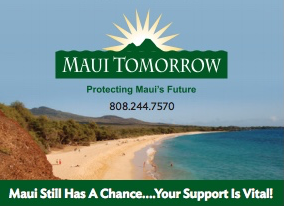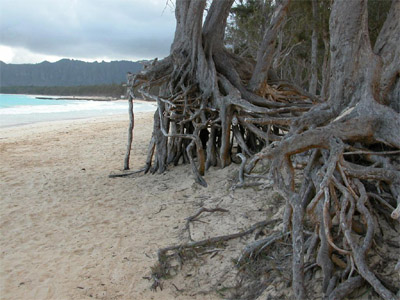Maui Tomorrow Foundation supports the draft programmatic environmental impact statement for the Hawaiian Monk Seal Recovery Plan.
The most controversial (and most misunderstood) action in the plan, Alternative 4, includes an option to temporarily move weaned pups from the Northwestern Hawaiian Islands. Only a limited number of healthy female pups would be brought to the main islands of Hawaii and, after passing the critical first three years of life, would be taken back to the northwest islands.
This would not lead to a noticeable increase in seal populations in the main islands and is, in fact, necessary because pups are no longer surviving this nursery period due to the man-made imbalances that exist in those remote waters. An overpopulation of Galapagos sharks and ulua are taking their toll on young seals, along with vast amounts of marine debris that entangle and kill them. Survival rates of monk seal pups have dropped from 80 to 90 percent in the 1970s to less than 15 percent today.
Rumors that Hawaiian monk seals hunt down twice their weight in fish daily are false. Local marine experts say rumors such as this about a highly endangered marine mammal found nowhere else in the world interfere with efforts to stop the species from sliding into extinction. In fact, the National Marine Fisheries Service hopes to work with Hawaii’s fishing community to find the least impactful locations to place young seals and to relocate any troublesome adult seals back to northwest waters.
Unfortunately, the circulation of false information and fearmongering by large commercial fishing interests has created concern that there may be a connection between the spreading of misinformation and recent seal killings on Kauai and Molokai. Our community needs continued education and outreach to counter misconceptions and reinforce the fact that monk seals are not a threat to any ocean user’s livelihood. Large-scale commercial fishing, pollution and stream diversion are much more to blame.
Opponents of the proposed recovery plan claim that monk seals are not a native species yet the Kumulipo makes mention of Ilio-holo-ika-uaua – “dog that runs in rough waters” – which many think is a reference to the monk seal. Some on the Big Island and Kauai say the monk seal is their families’ aumakua.
Although Hawaiian monk seals are not as prominent in Hawaiian legend and oli as other sea creatures – like turtles and sharks – many believe their cultural significance will soon be revealed with the translation of more olelo Hawaii newspapers, ship logs and other written materials from past centuries.
It’s time to support these recovery efforts because doing nothing will lead to the species’ extinction within the next 20 years. Alternative 4 of this PEIS gives the best chance possible to stop the steep decline in monk seal pups’ survival. It’s good science and good environmental stewardship. The recovery of the Hawaiian monk seal can only be an asset for the health of Hawaii’s ocean ecosystems and a tribute to the humanity of its people.
Comments on the Draft Hawaiian Monk Seal Recovery Actions PEIS will be accepted until Oct. 17 and can be submitted via email to monkseal@noaa.gov or mailed to NMFS PIRO, Hawaiian Monk Seal Recovery Actions PEIS, 1601 Kapiolani Blvd., Suite 1110, Honolulu 96814.
* Irene Bowie is the executive director of Maui Tomorrow Foundation Inc.



